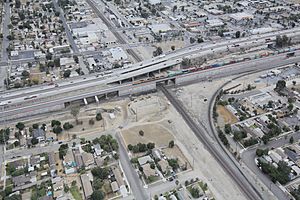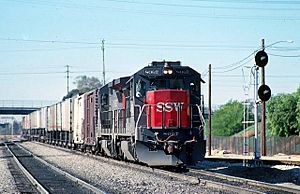Colton Crossing facts for kids
The Colton Crossing is a busy railway intersection in Colton, California. It is located just south of Interstate 10. This is where the important Sunset Route and the Southern Transcon train lines meet.
First built in 1883, this spot was once the scene of a big argument between railroad companies. This fight was called a "frog war." It even led to a face-off between famous lawman Virgil Earp and California Governor Robert Waterman. Back then, the tracks belonged to the Santa Fe (ATSF) and Southern Pacific (SP) railroads. Today, their successors, the Union Pacific (UP) and the Burlington Northern Santa Fe (BNSF) railroads, own the tracks.
At the crossing, the UP tracks run east to west. The BNSF tracks run north to south. (The BNSF tracks eventually turn west towards Los Angeles and Long Beach, running next to the UP tracks). Metrolink trains and Amtrak's Southwest Chief use the BNSF tracks. Amtrak's Sunset Limited uses the UP tracks. UP trains come from the east through the Coachella Valley. They go to the train yard in West Colton and then on to Los Angeles. BNSF trains come from the west (Los Angeles) and south (Riverside and Corona). They continue through the crossing to the yard in San Bernardino. From there, they head north to Cajon Pass and eventually Barstow on their way to Chicago.
History of the Crossing
Building the California Southern Railroad was tough. This railroad was part of the Santa Fe (ATSF) company. Its rival, the Southern Pacific Railroad (SP), often tried to stop its progress. One time, California Southern planned to build a crossing over SP tracks in Colton.
The California Southern engineer, Fred T. Perris, ordered the special track section needed. When the track arrived in National City in July 1883, SP officials acted fast. They hired the local sheriff to take the track section. The sheriff guarded the track day and night. But Perris's men managed to get the track back while the sheriff was napping! They quickly loaded it onto a train car. Then they started heading north towards Colton to install it.
Perris got a court order on August 11, 1883. This order legally allowed California Southern to install the new track section.
Jacob Nash Victor, a California Southern engineer, was in charge at Colton. He wrote a letter to the president of California Southern. He said they needed to make sure all SP workers knew about the court order. He also mentioned that a "riot" or big fight seemed very likely. So, he had the order sent by telegraph to the sheriff in San Francisco. This was to make sure SP leaders knew about it. Meanwhile, the sheriff in Colton had gathered a group of armed men. They were ready to clear the SP tracks if the court ordered it.
Perris's crew was ready to put in the new crossing. They waited for SP's Overland Mail train to pass. But then an SP train arrived. It pulled one empty train car and stopped right at the crossing spot. The SP engineer then slowly moved the train back and forth. This was to stop the California Southern crew from installing their crossing. Southern Pacific had hired lawman Virgil Earp to guard its tracks. He was riding in the train's engine.
The people of Colton supported Southern Pacific. But nearby San Bernardino residents were upset. Southern Pacific had bypassed their city. They hoped the California Southern line would bring their city back to life.
On the morning of September 13, things got very tense. This event was quickly called the "Battle of the Crossing." People from Colton and San Bernardino gathered on both sides of the tracks. San Bernardino residents were on the north side. Colton citizens were on the south. The Southern Pacific train was between them. Men on both sides carried tools like picks and shovels. Some also had shotguns and revolvers. Virgil Earp stood on the train, holding his revolver. People thought the empty train car held more SP men with rifles. They were hiding so no one could see them.
The Governor of California, Robert Waterman, stepped in. He ordered San Bernardino County Sheriff J.B. Burkhart to make sure the court order was followed. Burkhart chose 10 reliable men to help him. He personally took the governor to the crossing. Governor Waterman stood between the SP train and the San Bernardino crowd. He read the court order aloud. The governor said the train had to move right away. He told Virgil Earp that if he even touched his gun, the sheriff and his deputies would shoot. The tension was very high. A gunfight seemed possible. But Earp realized that fighting was pointless and would cause harm. He put his gun away and told the engineer to move the train.
The tracks were cleared, and the crossing was installed. The first train from San Diego arrived in Colton on August 21, 1882. The first train to San Bernardino arrived just over a year later, on September 13, 1883.
Modernizing the Crossing
The City of Colton was home to the Colton Crossing. This was a place where two main train routes crossed at the same level. Before a new project, this crossing caused huge traffic jams for trains. Over 110 trains used the crossing every day. This meant long delays for both the Union Pacific (UP) and BNSF railroads.
In 2006, a group called the Alameda Corridor Transit Authority (ACTA) studied the problem. They looked at ways to build a new structure. This structure would separate the UP and BNSF tracks at Colton Crossing. This would allow trains to cross without stopping. ACTA also suggested building a "flyover" bridge south of the crossing. This would reduce train conflicts and hours of delays.
The San Bernardino Associated Governments (SANBAG) worked with ACTA, UP, and BNSF. They held meetings with the community. This helped them choose the best plan. In November 2011, work began on the project. The final design was a 2.2-kilometer (about 1.4-mile) flyover. This bridge would carry the Union Pacific tracks over the BNSF tracks. The project was expected to take four years and cost $202 million. Skanska was the main company building it.

The Colton Crossing flyover project finished in August 2013. This was eight months ahead of schedule! Both BNSF and UP now have two tracks for their trains. One UP track was kept at ground level. This track is used for emergencies, switching trains, and reaching the West Colton yard.
New building methods helped finish the project quickly and cheaply. The final cost was only $93 million, much less than the $202 million planned. This new flyover has greatly reduced train delays. It saves travel time and cuts down on pollution. It also saves about $241 million in time that trains used to spend waiting.
Images for kids




